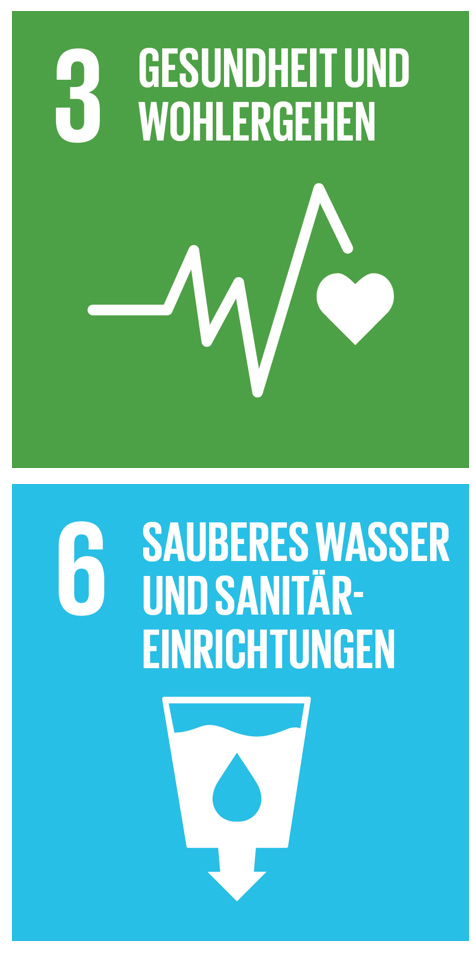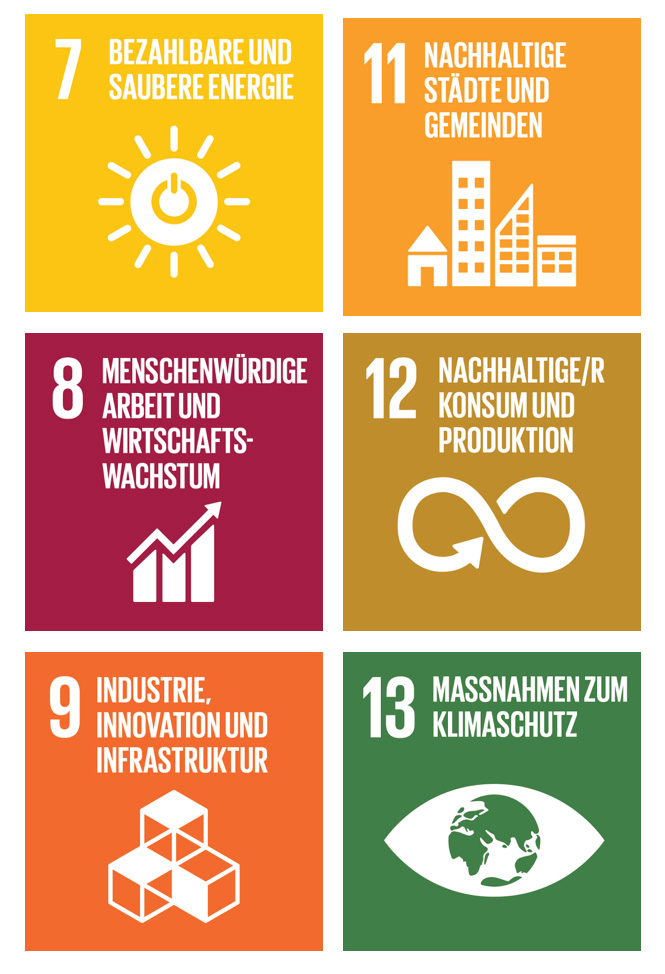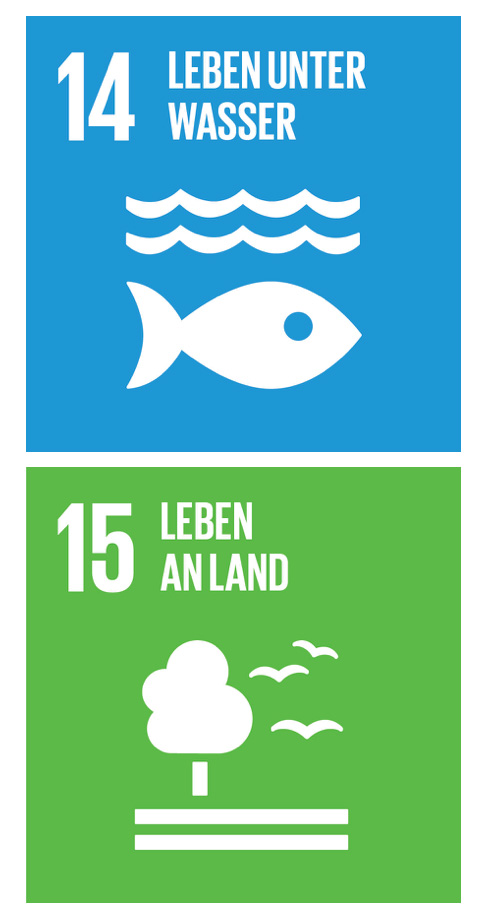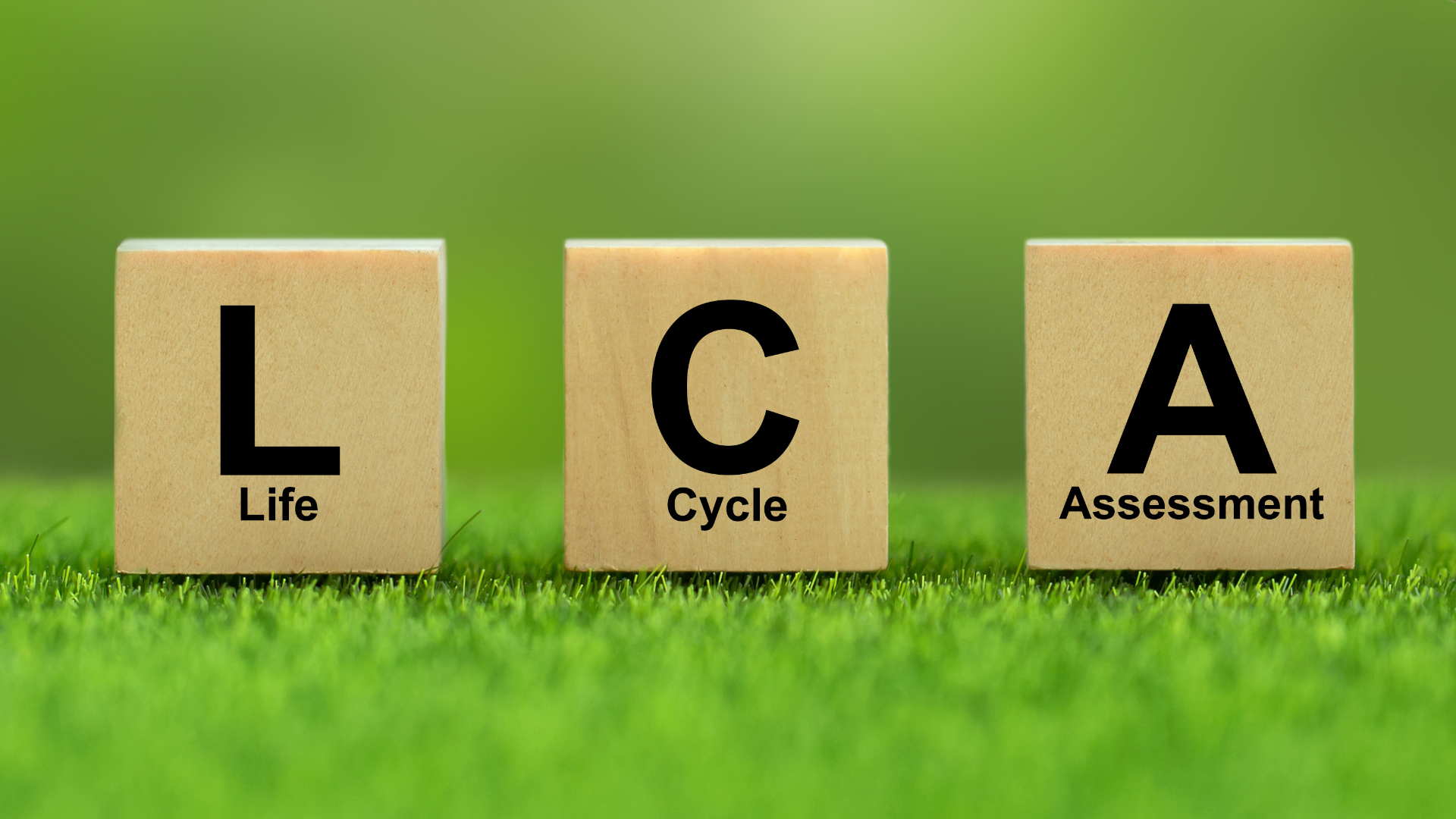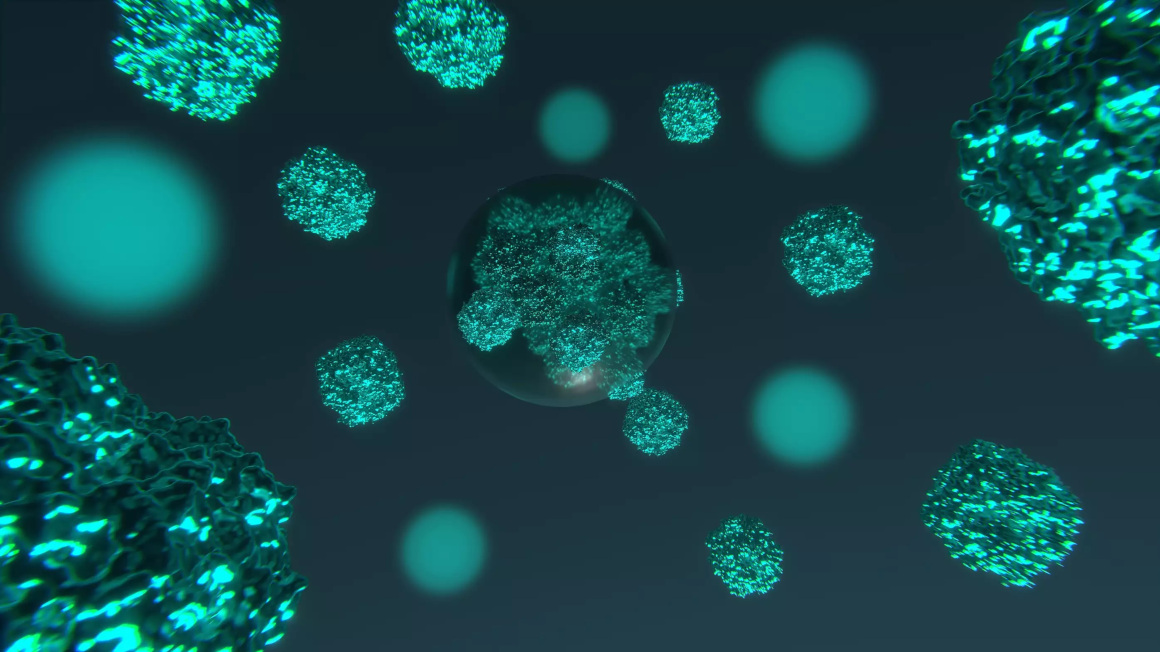1) What does sustainability entail?
The principle of sustainability, according to which no more wood may be felled than can grow back, has been applied in forestry for a long time. With it, Hans Carl von Carlowitz laid the foundation for sustainable forestry as early as 1713.
The foundation for the much broader concept of sustainable development, which is used today as a guiding political principle, was laid in the 1987 report of the World Commission on Environment and Development (WCED), chaired by then Norwegian Prime Minister Gro Harlem Brundtland. For this reason, the WCED is also known as the Brundtland Commission. Two formulations of the Commission are central:
Sustainable development is development that meets the needs of the present without compromising the ability of future generations to meet their own needs.
Sustainability is therefore understood to be the long-term viable development of the economic, ecological and social dimensions of human existence. The goal of sustainability combines precisely these three variables, with the preservation of the natural foundations of life in a global perspective as well as a life in dignity as underlying maxims. Sustainability is thus also a principle of justice - within societies, between generations and in the relationship between nations.
In 1992, the international community agreed on the guiding principle of sustainable development at the UN Conference on Environment and Development in Rio de Janeiro. The Rio Declaration formulates the shared responsibility to use the earth's resources in a way that provides all countries of the world with equal development opportunities without diminishing those of future generations.
Feeding a rapidly growing world population, climate change, the decline of biodiversity and an economic system that is often too resource-intensive: In response to the increasingly complex global challenges of our time, the UN adopted the 2030 Agenda for Sustainable Development in 2015. With the 2030 Agenda, the international community has set 17 Sustainable Development Goals (SDGs) with 169 sub-goals. All states are called upon to implement the universal benchmarks of the 2030 Agenda over the next ten years; however, this is not legally binding.
The UN Sustainable Development Goals strive for economically efficient, socially just and ecologically responsible development. The absolute baseline is the preservation of the natural foundations of life and the orientation towards a life in dignity for all. Important principles for considering sustainability are the planetary boundaries first established as a concept in 2009.These define a "safe margin of maneuver" that does not endanger the stability of ecosystems and the livelihoods of humankind.
Video: UN-Nachhaltigkeitsziele und Bioökonomie
Page 2 of 7
2) Sustainable bioeconomy on the political agenda
The guiding principle of sustainable development has also been established in European and German politics. In 2002, Germany adopted its first National Sustainability Strategy. With this, the German government made sustainability the guiding principle of its governmental action. The German Sustainability Strategy (Deutsche Nachhaltigkeitsstrategie, DNS), adopted in 2017, builds on its predecessor strategies and serves the national implementation of the 2030 Agenda and its 17 Sustainable Development Goals. In March 2021, the German government adopted a comprehensive further development of the DNS, thereby setting the central framework for the implementation of the 2030 Agenda in, by and with Germany.
In the DNS, the German government pledges to contribute to the rapid and ambitious implementation of the SDGs, to recognize the planetary boundaries and, to this end, not to achieve its own prosperity at the expense of the poorest countries. The path is not to be paved by technical progress alone, but by a far-reaching transformation of the way we live, combined with a cultural shift toward greater sustainability. The success of this is measured with the help of 66 indicators.
Bodies and framework programs for the German Sustainability Strategy (Deutsche Nachhaltigkeitsstrategie, DNS)
The German Council for Sustainable Development (Rat für nachhaltige Entwicklung, RNE), which was established in 2001, continues to play an important role. Its core tasks include developing inputs for the implementation of the DNS, identifying concrete fields of action and projects, and making sustainability a major public concern. Another body is the Parliamentary Advisory Council for Sustainable Development of the German Bundestag, which was founded in 2004.
As an overarching national innovation strategy, the German government's High-Tech Strategy (HTS) 2025 defines a separate field of action and various missions on the topic of sustainability. The new Research for Sustainability (Forschung für Nachhaltigkeit, FONA) strategy published by the Federal Ministry of Education and Research (BMBF) in 2020 is also strongly aligned with the 17 SDGs.

In 2018, the EU presented its new bioeconomy strategy. A year later, the EU Commission launched the European Green Deal, a transformative policy project to make Europe the first sustainable, greenhouse gas-neutral continent by 2050. Key objectives of the Green Deal are sustainable agriculture and food systems, climate protection, clean energy, industry and the circular economy.
The concept of sustainability is firmly anchored in German bioeconomy policy. The bioeconomy, and with it the transformation from an economy dominated by fossil raw materials to a biobased, sustainable economy, is an important future strategy for overcoming global challenges. The importance of a sustainable, biobased economy is already emphasized in the National Research Strategy Bioeconomy 2030, published in 2010, and the National Policy Strategy Bioeconomy. The National Bioeconomy Strategy was then published in January 2020. It is designed to make concrete contributions to the implementation of the SDGs.
Page 3 of 7
3) National Bioeconomy Strategy and the UN Sustainable Development Goals
The National Bioeconomy Strategy formulates as the first of its six goals to develop bioeconomic solutions for the 2030 Agenda. Among the UN Sustainable Development Goals (SDGs), the German government has identified eleven Sustainable Development Goals (SDGs) to which the bioeconomy can directly contribute. The design of the bioeconomy is to be aligned with these SDGs.
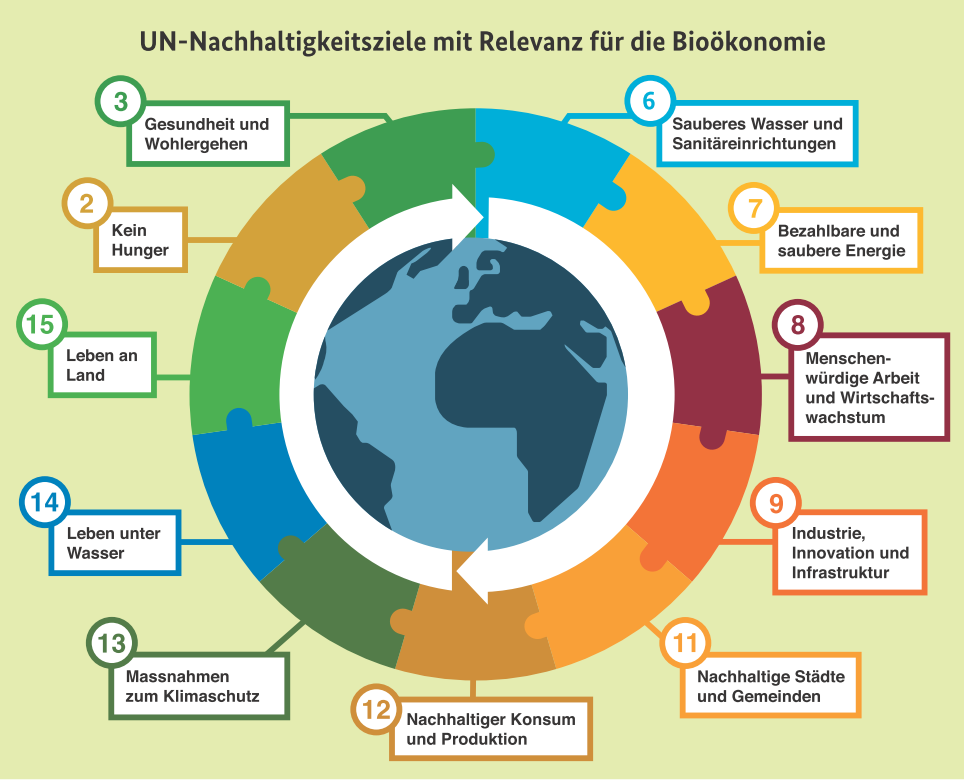
The National Bioeconomy Strategy describes three major subgoals to the first goal:
- Secure food for a growing world population;
- Limit the global temperature increase to 1.5 degrees Celsius through climate-neutral production;
- Protect, conserve and use biodiversity.
In the following chapters of this dossier, the contributions of the bioeconomy to the SDGs are presented on the basis of key challenges and core targets. In many cases, the various SDGs overlap. Particular attention is paid to the opportunities and potentials through research and innovation in the bioeconomy.
Page 4 of 7
4) Securing food for a growing world population
The challenge:
Climate change, dwindling arable land and the ever-increasing world population are making the global food supply an ever greater challenge in terms of quality and quantity. Urbanization, geopolitical instabilities, and the decline of biodiversity further exacerbate the situation.
Exemplary contributions from the bioeconomy:
The production of food and renewable resources is a mainstay of the bioeconomy. In the context of global challenges, a holistic view is needed of the complex interrelationships between the way we produce agricultural raw materials, process them into food, then transport and consume them or reuse or dispose of them. This is why the term "agricultural and food systems" is used.
Using bioeconomic innovations, the aim is to achieve sustainable agriculture based on modern plant breeding and new cultivation methods and technologies, taking into account all relevant abiotic and biotic factors. This is complemented by a diet that is not only sustainable from an ecological, economic and social perspective, but is also healthy and balanced.
Global food security is a priority in the bioeconomy. Biological knowledge and innovative technologies can make a decisive contribution to the emergence of sustainable and resource-efficient agriculture. The biomass produced by plants is the most important resource for food production. Thanks to modern plant breeding, the yield per unit area of many crops has already been increased enormously in the past. Moreover, with the new molecular biological breeding techniques, new tools have emerged only a few years ago that significantly accelerate the process of plant breeding. For the crops of the future, important desired traits include resistance to pests, diseases and weather extremes, but also adaptation to changing seasons or the efficient utilization of nutrients.
Soil as the basis of agricultural production is also increasingly becoming the focus of application-oriented research. The aim is to better understand the complex living environment of soil and to find ways to strengthen fertility and humus formation in soils, for example through balanced and diverse crop rotation and the cultivation of catch crops.This also includes influencing the microbial community in the soil and in the plant (microbiomes), microbial degradation processes in the soil, and novel fertilization concepts. Such findings help to optimize both conventional agriculture and organic farming.
Digitization, automation and other cross-cutting technologies have paved the way for more efficient and resource-conserving precision agriculture. Semi-autonomous agricultural machinery or robotic systems with satellite navigation and sensor technology can manage agricultural land in a demand-oriented, environmentally friendly and energy-saving manner (smart farming). In addition, better crop protection products are being developed. Combining cropping systems, such as agroforestry systems, can also contribute to food security. Closed-loop systems such as aquaponics are suitable for agricultural production in cities. Urban agriculture, including vertical farms, improves the supply of food to growing metropolises without long transports and pollution of water and soil, while using little land.
The production of food of animal origin can also be made more sustainable through innovative developments in the bioeconomy. With the aid of enzymatic feed additives, for example, livestock can utilize biomass more efficiently, and phosphate from plants becomes more readily available. Bioengineered amino acids as feed additives allow foods such as meat to be produced with less use of grain products. Increasingly, the potential of insects is being explored. This can be used to efficiently produce high-quality protein for animal feed or even for human consumption.
Furthermore, the blue bioeconomy - which uses aquatic biomass - opens up new opportunities: In addition to aquaculture of fish, mollusks and crustaceans, it includes the cultivation of macro- and microalgae. Algae provide valuable food supplements such as beta-carotene or omega fatty acids and proteins. Industrial biotechnology is already making important contributions to nutrition: for example, microbial production systems are used to produce bioactive ingredients that have a positive effect on health (functional foods). Novel approaches include microbially produced proteins for vegan dairy products. Innovative meat substitutes can also be produced in the bioreactor on the basis of cell cultures.
Global biodiversity is an existential basis for our food supply and agricultural production. Biodiversity is indispensable for soil fertility, plant pollination and pest regulation. Crop diversity, in turn, forms the basis for agriculture. In recent decades, however, the range of cultivated plants has become increasingly narrow. This promotes the emergence of pests and the development of resistance to pesticides. Increasing the range of varieties and species of cultivated plants and preventing the decline in biodiversity in agricultural landscapes are key objectives of the National Bioeconomy Strategy and the DNS.
Page 5 of 7
5) Focusing on health and well-being and their foundations
The challenge:
The Corona pandemic highlighted how quickly infectious diseases can have a massive impact on global health in an interconnected world. Global health threats and their management are closely linked to the UN Sustainable Development Goals. Accordingly, the effects of climate change and environmental pollution pose a threat to the health of the world's population. Similarly, water as a resource is critical to human well-being. Ensuring water supplies for all people is one of the major global challenges.
Exemplary contributions from the bioeconomy:
Biotechnology as an innovation driver in medicine
In medicine, biotechnology has become a major driver of innovation in the diagnosis and treatment of common diseases such as cancer, rheumatism and diabetes. Similarly, molecular diagnostics, vaccines and active ingredients are indispensable in the fight against the Corona pandemic. In biotechnology, microorganisms such as bacteria and fungi, but also plant or animal cells, are used to act as living biofactories that produce useful molecules in large quantities or convert substances.
What began in 1982 with human insulin produced by genetically modified bacteria has now become an important pillar for innovative therapies. Biopharmaceuticals, i.e., biotechnologically produced drugs, include vaccines, antibodies, enzymes and other therapeutic proteins used as medicines. Likewise, gene therapy approaches and molecular diagnostics are inconceivable without stem cell research and biomolecules.
For the industrial production of biopharmaceuticals, optimized microorganisms or other cells are cultivated in closed containers, so-called bioreactors. However, cell-free production, i.e., the biosynthesis of proteins or nucleic acids in reaction vessels and thus outside the cell, is also becoming increasingly important. A recent example would be the production of mRNA vaccines against the Corona virus, which is predominantly cell-free. Furthermore, bioactive additives for functional foods that have health-promoting effects are usually produced biotechnologically.
Global biodiversity and the diversity of the earth's ecosystems represent a gigantic resource for new active substances and medicines and thus for bioeconomic utilization: The worlds of plants and microorganisms are virtually inexhaustible sources of natural substances that have a medicinal effect and can be used as remedies. Equally, however, the bioeconomy aims to contribute to the protection and conservation of this important resource.
Conserving water as a resource
Through biomass cultivation, the biobased economy has a significant impact on water supply and the quality of ground and surface waters. The bioeconomy offers a whole range of approaches to help reduce water pollution: The strategic goal of a sustainable bioeconomy is more resource-efficient agricultural production with reduced consumption of water, pesticides and fertilizers. Greater crop diversity, perennial crops, modern irrigation technologies and improved soil management can help prevent nutrients and sediments from being washed out and thus polluting water bodies. The development of heat-resistant plant varieties is also intended to reduce water requirements for cultivated varieties.
In urban agriculture, i.e., in metropolitan areas and their immediate surroundings, people often rely on closed-system recycling of raw materials. Thanks to precise control, the use of fertilizers and pesticides can be dosed much more accurately and, at the same time, growth can be influenced efficiently. As a result, less phosphat, nitrate as well as pesticides end up in the soil and ultimately in the groundwater or rivers, which in turn serve as a source of drinking water for many people. In the future, local microbial treatment plants will convert wastewater to a state that is safe for irrigating local urban food growing systems.
In wastewater treatment plants, microorganisms are the central players in the biological treatment stage. They break down organic substances - especially organic nitrogen compounds. Currently, the use of biocatalysts is being tested in the so-called fourth purification stage, in which trace substances and chemicals such as xenobiotics are degraded.
Good management of forests and woodlands is equally important: forests are indispensable water reservoirs and filters. However, they are not only oxygen factories and CO2 reservoirs, but also indispensable for people's well-being as areas for recreation and experiencing nature.
Page 6 of 7
6) Sustainable management and consumption for a sustainable future
The challenge:
On the way to a sustainable economy, it is necessary to reconcile the pursuit of prosperity and economic progress with social justice and ecological compatibility. The major challenges in this context include climate change, securing energy and raw materials, but also conserving and protecting resources. On top of this, the needs and requirements of consumers must be taken into account.
Exemplary contributions from the bioeconomy:
Sustainable economic growth
Bioeconomy is a building block for sustainable, biobased economic growth. By switching from petroleum-based to biobased materials, using regenerative instead of fossil fuels, and introducing novel production processes, finite fossil resources and thus the climate can be conserved. The principle of the circular economy further ensures that substances and materials are used, reused and recycled for as long as possible and that energy and material flows are closed. Using resources efficiently is economically profitable and ecologically valuable.
Innovations in the bioeconomy are based on the smart use and interlinking of biological knowledge. Novel products and processes offer opportunities for greater competitiveness. In this way, the bioeconomy helps to develop the technologies and jobs of tomorrow. For example, materials with improved properties can provide an alternative to petroleum or concrete and enable resource-conserving and more durable construction.
In areas where the bioeconomy creates value-added innovations, this is potentially accompanied by new job profiles, more employment and thus additional income. In turn, this impacts other sustainability aspects such as health, education and social inclusion. Furthermore, the growth of the bioeconomy can promote local value creation and rural development. This is particularly the case by ensuring that the production of biobased substances and materials takes place, at best, as close as possible to the production of the necessary feedstocks and materials (decentralized value chains).
With the Corona pandemic, the demand for resilience as a principle of sustainable development has come to the fore. Resilience refers to the ability of a defined system to respond robustly and adaptively to short-term shocks or long-term stress from outside. Sustainability strengthens this resilience to crises - and bioeconomy is an important factor in this context.
Sustainable industry
With a view to climate, environmental and health protection, a major step toward sustainable industry lies in the substitution of products and services based on fossil or other finite raw materials with those based on biogenic resources. In particular, by using residual and waste materials for the biotechnological production of basic chemicals and high-quality downstream products, the earnings situation and thus the crisis safety of companies can be improved.
The industrial bioeconomy is concerned with the development and establishment of industrial processes that use biological resources or principles for the production of valuable substances or the development of innovative services. Biotechnological processes, such as microbial fermentations or biocatalyses, are widely used for the production of chemicals, biopharmaceuticals or food additives. Industrial biotechnology, also known as white biotechnology, uses organisms or individual biomolecules such as enzymes as the basis for industrial production. The high performers here are microorganisms and other cells that can produce a desired product in large quantities in closed bioreactors.
An expansion of the bioeconomy could also reduce dependencies on international raw material markets. Combined with a circular economy and recycling systems, bioeconomy enables national economies to achieve greater autonomy in the procurement of raw materials.
Furthermore, the industrial bioeconomy opens up enormous potential for novel value chains and products with innovative properties and functionalities. This becomes clear, for example, in the case of plastics, that are expected to retain their high functionality while being both biobased and biodegradable. The latter is an important step in addressing the global plastic waste problem. Still young is the industrial sector that uses the greenhouse gas carbon dioxide as a raw material for chemical syntheses with the help of microorganisms. This prevents emissions from other industrial processes from additionally contributing to climate change.
Sustainable cities and communities
There are several ways in which cities can benefit from a bioeconomy - ideally complemented by a circular economy. Many approaches to urban bioeconomy involve important innovations for cities and communities. These include sustainable management and efficient use of natural resources, greening of open spaces and buildings, and intelligent management of material flows, for example through innovative reuse of waste and wastewater.
Urban agriculture not only has a positive influence on the microclimate in cities, but also ensures greater independence in the supply of food, including short and thus climate-friendly transport routes. Concepts such as vertical agriculture - i.e., plant cultivation and animal husbandry in multi-story buildings, hydroponics and aquaculture - can help to close regional material cycles and thereby make life in cities more sustainable.
Infrastructure plays an important role in this. Along with the transport sector, the focus is on sustainable construction: Cement and concrete cause high CO2 emissions in their current production processes. Biobased building materials such as wood, on the other hand, are climate-neutral, good CO2 stores and also suitable for most applications, including building construction. Often, they even offer advantages for the living climate. In addition, research is currently developing concrete materials that can be produced from regional plant-based raw materials.
Sustainable production and consumption
Due to its biobased resources and processes, the bioeconomy offers a good basis for sustainable production. Fossil raw materials, whose extraction and use are associated with environmental and climate problems, are being replaced by materials that, in the best case, are climate-neutral and biodegradable. In this context, resource efficiency and the recycling of biological waste materials are important strategic goals: Enzymatic manufacturing processes used in industrial biotechnology save a lot of energy and avoid problematic waste products compared to classic chemical processes.
Biorefineries are one example of resource efficiency in industrial production processes. These are large technical plants in which plant biomass is broken down into its constituents and used or refined as much as possible - analogous to a petroleum refinery. Typically, several products are manufactured in a single process. In addition, the material use is coupled with energy generation.
A central goal of the circular economy is to use resources more efficiently and thereby extend the durability or service life of products. For this reason, product designers today are increasingly looking at the entire life cycle of products, all the way to their disposal. Considerable progress has already been made in this area in the automotive industry and also in the packaging industry.
A transformation has also begun in other industries where consumers are increasingly asking for sustainable and biobased products - for example, in the textile industry. Here, more and more emphasis is being placed on materials that produce few CO2 emissions during their manufacture. Additionally, the use of recycled materials helps to conserve resources. Biobased innovative materials are also in vogue, such as fibers made from biotechnologically produced spider silk proteins.
Biotechnological processes can be used for the recycling of precious metals (microbial mining). For example, there are approaches to extract gold from ground platinum scrap with the help of certain microorganisms. Biomolecules and biological degradation processes can also drive microbial mining: For instance, special enzymes can be used to filter chemical residues out of water. Furthermore, there are microorganisms that succeed in decomposing petroleum-based plastics.
Bioenergy and climate protection
Among renewable energy sources, biomass is considered an all-rounder. It can be used to generate electricity, heat and fuels. This makes bioenergy an important component in the energy mix of the future. The advantage of energy sources derived from biomass is that they only release as much CO2 as they have previously absorbed from the atmosphere. Moreover, they can be used directly where they are produced or accumulated as residual materials. Biomass can be stored and bioenergy plants can be flexibly controlled. Therefore, bioenergy is seen as an important component in balancing the fluctuating supply of wind and solar power. Also, energy from biomass can be generated decentrally. This means that places that cannot be reached by large power plants due to the lack of power lines can be supplied with electricity.
One example are biogas plants: Here, biomass from plants, manure or crop residues is converted into biogas and other fermentation products. Biogas - a mixture of methane and carbon dioxide - can be converted on site into electricity and heat. Biochar can also be produced from plant and fermentation residues. Biobased liquid fuels have the potential to make the transportation and mobility sector more sustainable.
From renewable raw materials, yeasts produce bioethanol on a large scale. This is used, among other things, to produce biobased gasoline, which is blended with premium gasoline (E10). Bioethanol is produced either from sugar- or starch-containing fruits such as sugar beet or wheat, and now increasingly also from lignified plant residues such as straw and wood residues (cellulosic ethanol). Such second-generation biofuels also exist for biodiesel, which is conventionally produced from rapeseed. For example, trials are currently underway to produce biodiesel from old French fry fat.
Intensive efforts are being made to find methods to utilize the entire plant and, in particular, organic waste streams as effectively as possible. Thermochemical utilization concepts that can be used to produce so-called biomass-to-liquid fuels are being considered for this purpose. Here, the molecules in the biomass are converted at high temperature into a synthesis gas and then into liquid fuel.
Microorganisms are coming into focus in the industrial bioeconomy as cell factories for fuels: Microalgae have great potential for biofuel production. For example, they produce fatty oils that are suitable for the production of biokerosene. Some microalgae are also capable of biologically producing hydrogen. Here, research is currently still being conducted into economical and efficient production.
The bioeconomy offers further solutions in the fight against climate change: The protection of natural areas - such as forests, meadows and moors - and the development of alternative forms of agriculture and livestock farming can ensure that carbon dioxide is stored.
Page 7 of 7
7) Protecting biodiversity
The challenge:
Besides climate change, the loss of biodiversity is one of the major global environmental threats and one of the greatest challenges facing humanity. Agriculture and forestry are facing tensions here: biodiversity is an important resource, yet at the same time, intensive forms of agriculture and forestry with ever-larger areas under cultivation are among the main causes of global species decline.
Exemplary contributions from the bioeconomy:
The diversity of species, genes and habitats makes up the biodiversity on our planet. Biodiversity not only secures existential livelihoods, it is also an indispensable resource for the biobased economy. Global biodiversity and the diversity of the earth's ecosystems provide the basis for agriculture, for new active pharmaceutical ingredients, for biotechnology and for material sciences. The National Bioeconomy Strategy aims to develop bioeconomic solutions for the sustainability agenda that not only use biodiversity, but also help to protect and conserve it.
Understanding agroecosystems
Current bioeconomy research is increasingly seeking holistic approaches: The focus is on ecosystems and their interaction in agricultural production. For example, agricultural production depends on ecosystem services (such as pollination, soil fertility) and must itself contribute to the maintenance of these ecosystem services. Therefore, it is necessary to view agriculture and forestry in a holistic sense as agroecological systems. Accordingly, the goal of the National Bioeconomy Strategy is to expand our understanding of the interrelationships of ecosystems - both in basic research and in the development of application-oriented approaches. Views are needed that evaluate production systems not only according to their yield, but also according to their ecological services.
Marine bioeconomy
The goal of the blue bioeconomy is the sustainable use of marine fauna and flora (such as algae), among other things for the purpose of developing and producing food, cosmetics and biopharmaceuticals. Research is developing sustainable forms of aquaculture to protect fish stocks worldwide and maintain the maritime balance.
Preventing pollution of water bodies helps to preserve and protect the biodiversity of organisms. Modern plant breeding and precision agriculture can help reduce the amount of pollutants entering aquatic ecosystems by reducing the need for fertilizers and pesticides. The same is true of high-tech closed-loop production systems, where better dosed supplies of nutrients prevent surpluses from entering the environment. In chemical production, biotechnological processes often avoid water-toxic waste materials that can be generated by standard chemical-synthetic processes.
Protecting and using diversity in terrestrial ecosystems
In order for terrestrial ecosystems to manage soils and forests in a sustainable manner, the focus needs to be on crop diversity and innovative agricultural systems. Cultivating alternating crops (crop rotations) not only reduces soil nutrient depletion, but also conserves water resources in the soil. Soil and plant breeding research, as well as digital approaches, are providing new solutions here. These include resistant crops that require less fertilization and less frequent treatment with pesticides.
New food sources such as insects or meat substitutes are emerging as alternative sources of protein, thereby reducing the pressure that agricultural production exerts on terrestrial ecosystems. Certain energy crops such as perennial grass also help restore fertility to wastelands and halt erosion. In addition, certain plants and microorganisms from environmental biotechnology can remediate polluted soils and extract salts or heavy metals. With regard to forestry, forests threatened by climate change can be converted and made more resilient to droughts and other weather phenomena in order to prevent losses of forest ecosystems. Reforestation also makes a contribution.



